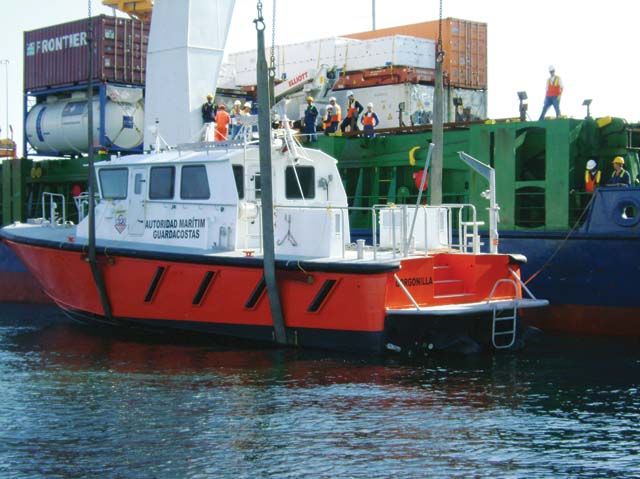Boatbuilders are always looking for new markets. After being contacted by brokers in South America, Gladding-Hearn Shipbuilding found a new one — Colombia.
Late last year, the Somerset, Mass., yard delivered the first of six Chesapeake-class pilot boats to the Colombian Department of the Navy. “That’s the first time we’ve been in that market,” said the boatyard’s Peter Duclos.
The 56.6'×17.8'×3' deep-V, aluminum pilot boat was designed by C. Raymond Hunt & Associates.
Duclos said the Colombian navy “is all things maritime.” Thus the pilot boat will be involved with base security, drug patrols, survey work and piloting, but won’t be used in combat.
There are long distances between ports in that part of the world, which means extra fuel tanks for the Colombian boat, giving it a range of about 800 miles. That’s opposed to 250 to 300 miles common on U.S. pilot boats.
Crew comfort is important running those distances, so there’s a full galley, air conditioning, Llebroc seats, an upholstered settee and six bunks.
Duclos said the boat operates where there is a lot of debris and will often be running in shallow water, which explains the choice of UltraJet UJ-452 waterjets instead of a shaft, prop and rudder arrangement.
The two jets are matched up to a pair of 800-hp MAN R6-800CRM diesels through ZF 360 gears. Electrical power comes from a 16-kW Alaska Diesel genset.
If building boats for a new customer is satisfying, it’s probably equally satisfying building a new design. For Gladding-Hearn that’s the new generation Chesapeake-class pilot boat, which measures 52.7'×16.8'×4.5'.
The first new pilot boat will be trucked out of the Somerset boatyard in 2015 for the Tampa Bay Pilots.
What’s different about this design is the pair of Volvo Penta IPS2 pod systems with dual, forward facing, counter-rotating propellers and an integrated exhaust.
“We talked to a lot of pilots and they want more comfort, more speed and better fuel economy,” said Duclos. What makes all that possible is the IPS2 propulsion system.
Each propulsion pod unit is connected to a 503-hp Volvo Penta D11 diesel. Because the engines and pods are connected, the engines can go farther back in the hull, thus allowing the wheelhouse to also be moved back. That makes crew quarters more comfortable, while allowing the machinery spaces to be accessed through the deck. This avoids having to go through the wheelhouse for maintenance and repairs.
The smaller engines are lighter yet we “manage to obtain reasonable weight for the boat so it’s still comfortable and efficient,” said Duclos.
The boat hits about the same top speed — 27 knots — as larger Chesapeake-class pilot boats, but does it with smaller engines, thus fuel economy is improved.
Maximizing fuel economy, acceleration and improving comfort was also behind the decision to go with the Humphree Interceptor trim-control system. This is an automatic trim control system that adjusts the trim for a given speed.— Michael Crowley




